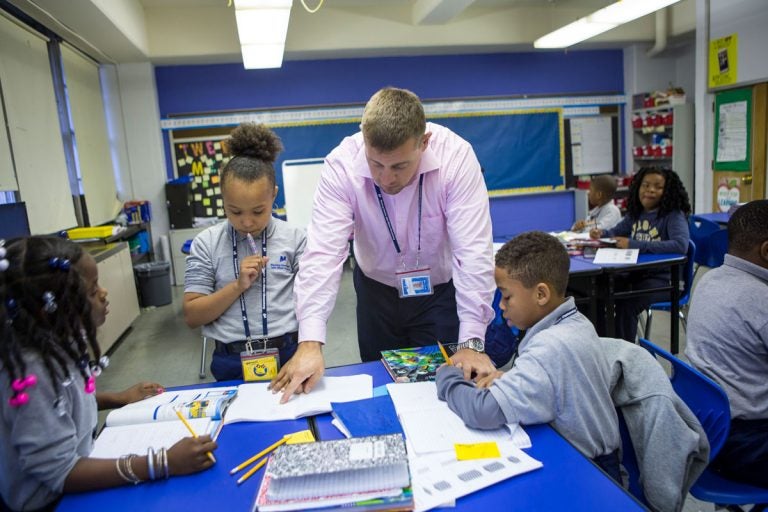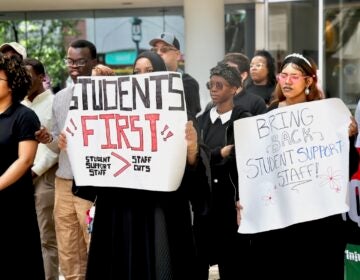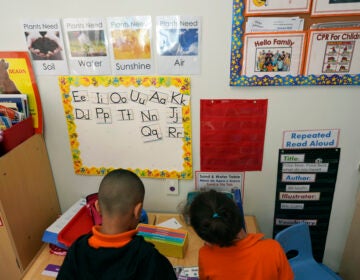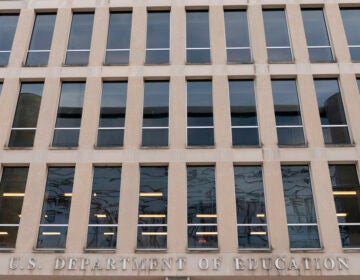Eight school districts sue N.J. Department of Education over cuts in state aid
The eight school districts are saying reductions will devastate the learning environment for thousands of students.

Nate Higgins works with students on math problems. (Jessica Kourkounis/WHYY)
Eight school districts are suing the state Department of Education over planned cuts in their school budgets, saying the reductions will devastate the learning environment for thousands of students.
But Senate President Steve Sweeney (D-Gloucester) says those districts should have seen the writing on the wall.
When Democratic Gov. Phil Murphy signed Sweeney’s school funding reform bill (S-2) into law last year, many heralded the move as a positive step toward equal funding for all districts. In redistributing the money the state spends on education, however, there were inevitably going to be some cuts. Especially for those districts still receiving “adjustment aid” that was supposed to be phased out years ago. Now, some of the districts getting less are taking the state to court.
Brick, Jackson, Manalapan-Englishtown, Toms River Regional (which includes petitioners Borough of South Toms River, Borough of Beachwood, and Borough of Pine Beach), Lacey, Freehold Regional, Weymouth, Ocean Township, and an individual taxpayer are petitioning the state regarding their school aid, alleging the changes to the formula are unconstitutional and are forcing them to shutter programs, fire teachers, and increase class sizes.
“It’s madness,” Mark Tabakin, a lawyer with Weiner Law Group representing the school districts said. “These districts are facing very difficult decisions and it’s all going to affect children. When you are forced to reduce a budget by $25 million, what do you think is going to happen? When you eliminate staff and programs, it’s the children that suffer and the taxpayers suffer by trying to make these districts whole again.”
Fact checking
No school district suing lost $25 million over one year. Brick saw cuts of $1.2 million in aid from the prior school year; Toms River more than $991,000; and Freehold Regional, nearly $1.3 million. Those numbers do become significant over a seven-year phase-in. Brick for instance, will lose more than $22 million, Toms River more than $18 million.

The districts are asking the state for increased transparency on how the formula works and a more “equitable and predictable” distribution that allows them to plan for the long-term health of their districts and communities.
In response, Sweeney said several of these schools have been overfunded for years and will need to cut back in order for other underfunded districts to get a deserved increase in state dollars.
“I get offended when I hear these districts talk about ‘it’s unfair.’” Sweeney said. “What was unfair was when they were overfunded for the last nine years and they’re buying iPads for all their kids and other school districts are sharing books.”
Mysteries of school funding explained
New Jersey has long relied on its extremely complicated school-funding formula set out in the 2008 School Funding Reform Act to determine how much money to allocate each school. In theory, the state is supposed to calculate how much a district needs to adequately educate its students (its “adequacy budget”) and how much the community can provide through taxes (“local fair share”). The rest would be made up by the state (via “equalization aid”). In practice, Tabakin said, the formula is “flipped,” meaning the state dictates how much funding a district needs, then says how much it can provide that year, and the rest is on the shoulders of the taxpayers.
“Taxpayers are already overburdened, and now the state is foisting responsibility on them,” Tabakin said. “That’s the problem we’re facing and that isn’t fair.”
For Stephanie A. Wohlrab, the taxpayer listed on the lawsuit, the changes under S-2 will mean she “must pay more than one hundred percent of the proper Local Fair Share,” according to the filing.
When S-2 passed last year, one of the biggest changes was the elimination of adjustment aid — money that districts had been receiving on top of their formula funding. The idea was to rebalance funding based on the changes in districts since the formula was instituted by the Corzine administration. When the formula was initially adopted, nine years ago, there were municipalities that would lose funding. To soften the blow, they would get adjustment aid, which has never been reduced or eliminated until now.
Another change was the removal of the state-aid growth limit or “enrollment cap,” which severely limited how much money any district could gain in a year. Under the growth limit, an underaided district (one that is not meeting its adequacy budget) could only get a 20 percent increase over what it received in the previous year. Any district spending above adequacy could get at most 10 percent of its previous year’s allocation. Essentially, the enrollment cap meant that even as the number of students changed in a district, the flow of new aid was limited.
Defining the state-aid differential
With those two elements gone, S-2 instead implemented a “state-aid differential” equation that was intended to ease the transition for any district that would see massive cuts by spreading the reductions over seven years. The differential equation sorts districts into two categories: underfunded and overfunded, by calculating the difference between what a district got last year in state aid and the amount it would get for the current year. Under the new formula, if that difference is negative, the district is underfunded and will get more aid. If the difference is positive, the district is considered overfunded and will see cuts.
Those changes sent some districts and administrators reeling, including Freehold Regional High School District superintendent Chuck Sampson.
“It’s an oversimplified solution to a complex issue done in a highly politicized way and it hurts students. To bucket everyone as underfunded or overfunded is incredibly flawed and problematic,” Sampson said. “We’re operating at extreme efficiency already. We have classes 28-30 deep in high school and our per-pupil spending is below the state average.”
Faced with more cuts, Sampson said Freehold is heading toward a “financial cliff.”
To cover costs for this school year, they will be drawing down their reserve funds “to dangerously low levels,” jettisoning teaching staff, gutting transportation, and cutting school activities. But this will still leave them vulnerable to unforeseen problems.
“If you’ve got a boiler that goes, we erode our ability to take care of those capital projects” Sampson said.
He added that as the state is considering more regional school districts, the impact on Freehold should be taken seriously.
“To take a district like ours — the largest regional high school (district) in the state — and to reduce us when we’re already operating at incredibly high efficiency rates financially is just bad on the state’s end,” Sampson said.
According to the filing, Freehold Regional will be eliminating staff from most departments; increasing class size significantly; and cutting student services like “social, emotional, and psychological supports.” The filing also said that the district will be “unable to comply with its strategic plan, which identifies district priorities and projects to be implemented through the 2021-2022 school year.”
The property-tax problem
Sweeney said the problem for many of these districts and the reason they are unprepared to deal with the cuts is that they have been undertaxing their communities for years, knowing that they would be getting adjustment aid to make up for any shortfalls.
Indeed, the SFRA formula says districts can levy a tax on residents up to 2 percent to fund municipal and local schools. Freehold and the others have not been taxing to that full 2 percent increase each year.
Gerard Dalton, superintendent in Brick, said keeping taxes low for citizens was a matter of “fiscal responsibility.” He said because they had been undertaxing, they were unlikely to be approved for any emergency aid to cover their cuts. As a result, the lawsuit was their last resort.
“We filled out (an) emergency aid application. The documentation for that was voluminous and we were denied. We were then told we could appeal that and we did. We’ve not heard anything back.” Dalton said.
Sweeney, meanwhile, said voting “no” on property-tax increases harmed other districts.
“They’re spending money for kids they never had. That’s not fiscally responsible. That’s taking other kids’ money,” he said.
But for some districts, even bumping up property taxes by the maximum 2 percent legal increase over the year before will not cover their first year cuts, and that’s something Sweeney said he’s willing to consider.
“We should look at giving them the ability to make up just for what they lost, but that’s a conversation we have to have with the Assembly,” Sweeney said. “If you lose a million dollars you should be able to go and get that million.”
The changes to the school-funding formula also authorize former Abbott districts that would lose adjustment aid to exceed that 2 percent spending cap to raise property taxes to their full local fair-share amount.
Taxpayers can vote by referendum to pay more than 2 percent, but putting it on the ballot is a risky move.
Charged with ‘unpredictability’
Another charge being brought against the state in the lawsuit is the “unpredictability” of funding. Dalton pointed out his district used the initial state aid numbers released with the budget before S-2 passed to strike their own school budget. But they were then told that money would be taken away. That forced them to strike a new budget with limited time and significantly less money.
Sweeney, however, said he warned districts last February, right around the time the budget was released, that the state aid numbers in Murphy’s budget would not be accurate. He was anticipating the passage of S-2 and knew that another factor would play a big role: changes in enrollment.
When enrollment falls
Sweeney said another reason these districts should have seen the cuts coming is that enrollment has dwindled dramatically since 2008-2009 — the last time the SFRA formula was recalibrated. Toms River has lost 1,777 students as of the 2017-1018 school year, while Brick has lost 1,650. Even smaller districts like Ocean Township and Lacey lost 652 students and 824 students, respectively. For Sweeney, this equates to effectively cheating the state out of funding.
“They were getting funded for kids they didn’t have, they were getting it for nine years,” Sweeney said. “They should have been shrinking and adjusting and they didn’t. They spent the money and didn’t go back to the taxpayers like they should have.”
Dalton said it’s important to understand that despite a dip in overall enrollment, all of the districts suing saw an increase in “at risk” students — English-language learners and those eligible to receive free or reduced lunch. The number of at-risk students adds weight to the adequacy-budget portion of the formula and raises the amount that each district needs to educate its kids. According to DOE data, Ocean Township, for example gained 389 at-risk students between the 2008-2009 school year and the 2017-2018 school year. Similarly, Toms River saw an increase of 1,561 at-risk kids; Brick gained 1,187 at-risk students.
Dalton said the formula fails to take the impact of those intricacies into account. But Sweeney maintained that “the money follows the child” and the formula reflects that.
“We need a formula that considers the uniqueness of pushes and pulls in communities and what that means in a classroom,” Dalton said.
The problem with PILOTS
Yet another problem the districts list in their suit is a tax-abatement snafu.
A district’s local fair share is calculated by factoring in a municipality’s ratable property base: property values and residents’ incomes. Yet it does not account for a tax-abatement agreement known as payments in lieu of taxes (PILOTs). These agreements were designed to stimulate development in struggling communities, but they do so by diverting overall tax revenue that would otherwise pass to local schools. In some cases, PILOTs can last up to 30 years and generally result in 95 percent of each payment going directly to the municipal government and 5 percent going to the county government — leaving nothing for schools.
The lawsuit alleges that “the SFRA still fails to account for the true wealth of a community in its funding formula,” because it does not take PILOTs into account. But developers have argued that successful PILOTs indirectly add overall value to schools by increasing the value of surrounding areas in a municipality.
Sweeney is currently working on legislation that would take a closer look at the impact of such deals.
As the Legislature works on solutions to some of these issues, districts suing the state are awaiting movement on their case.
“Everyone recognizes the difficulty the DOE faces and these school district face. The financial resources are scarce, and there is a finite amount of state aid,” Tabakin said. But “the SFRA says funding should be predictable and equitable and it has not been. That needs to get fixed.”
WHYY is your source for fact-based, in-depth journalism and information. As a nonprofit organization, we rely on financial support from readers like you. Please give today.




